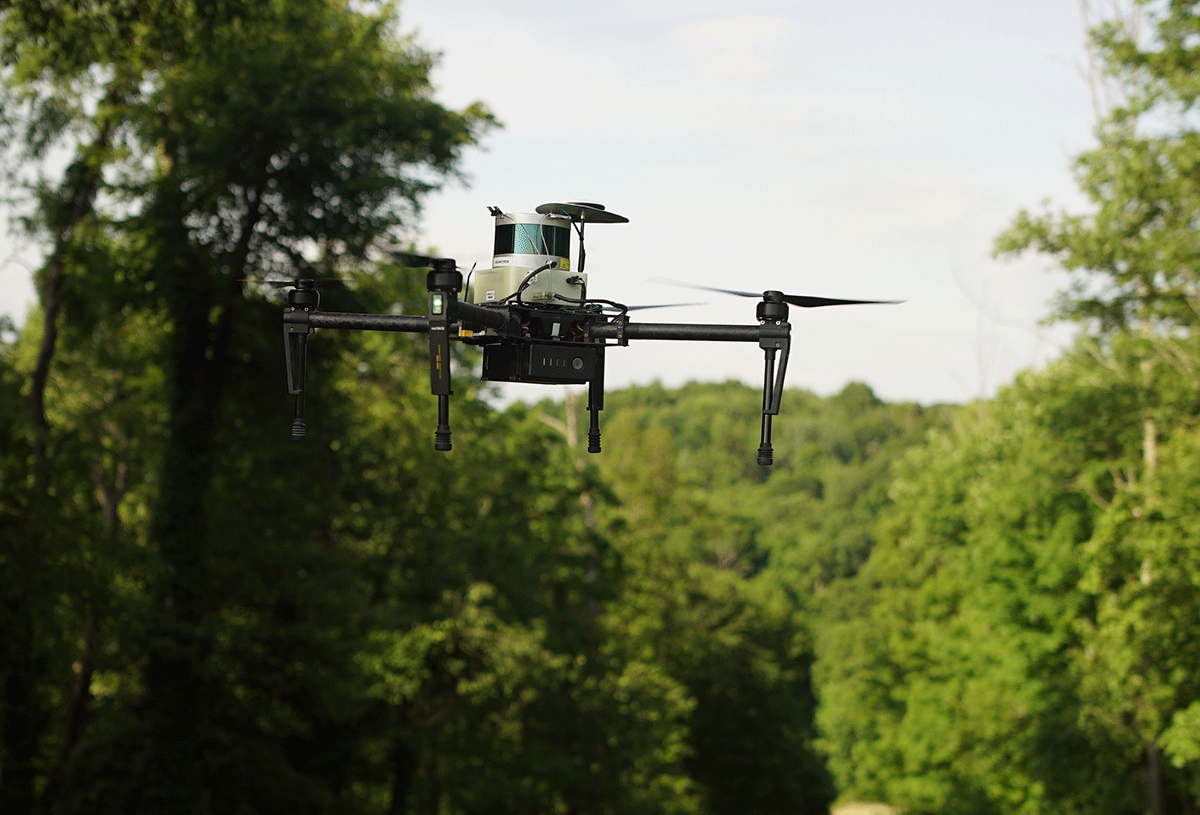The development of a UAS traffic management (UTM) system is something I’ve been covering recently, as it’s a topic which could inherently change the way people think about drone flight. Simply put, the system would allow drone operators to easily communicate with and identify one another in a safe manner while flying in the national airspace system (NAS).
NASA has been hard at work developing the logistics of this system, and recently flew 22 drones simultaneously to assess rural operations of their UTM research platform. That test showcased how far this research has advanced, but new developments will still need to be created to make this system viable for the community at large.One of the companies working on those exact sorts of developments is Pittsburgh-based, Near Earth Autonomy, and they recently announced the creation of Safe50, the first system of its kind that will ensure safe UAS operation through all phases of flight. Details of that announcement are available via the press release below, but I wanted to explore some of these details a bit further. Near Earth’s CEO, Sanjiv Singh, was kind enough to take the time to talk through some of my questions. A video that showcases their solution is also below. Jeremiah Karpowicz: I know that Near Earth is a spin-off from Carnegie Mellon, but can you give us a little more detail about the history of the company?Sanjiv Singh: I was working in the autonomous ground vehicle area for many years at Carnegie Mellon as a scientist and professor. Over the years I saw an opportunity for air vehicles, especially low-flying air vehicles, in terms of being able to use some of the same concepts that we use in autonomous ground vehicles, which we now call self-driving cars. We started some pilot programs, mostly for the Defense Department, and there seemed to be a lot of pull for our work that led to some opportunities that weren’t appropriate for the university. We had a chance to do a big program, so we started a company to do that.Near Earth comes from a long tradition of autonomy with cars, but now there are a whole lot of other things going on with air vehicles. What we’re looking at is technology that makes air vehicles fly with great safety, efficiency and performance, and we do that by enabling a cognizance of the world around the air vehicles. This is critically important when you’re in low-altitude flight, or near-Earth flight. What about Safe50? How did you get involved with this development?Once sub-program of NASA’s UTM program is called Safe50. NASA envisioned this idea and had a solicitation for technologies to support Safe50. Our company had formed long before this solicitation was out, but we had been thinking about these sort of near-Earth operations the entire time.Safe50 epitomizes the drive to push into the first and last 50 feet. The focus of that program is the first and last parts of the flight, because that’s where the complexity is, and fits very well with what our company is about. This program will eventually be very helpful in the commercial space, because if you’re going into the NAS, you have to be safe, because the risk is high if you’re flying without that cognizance of the environment. What do you think made your proposal stand out?We had been watching what the FAA was saying, and we ourselves had distilled three criteria of what the FAA was asking for before large-scale operation of UAVs in the NAS is possible or even acceptable to them.Those criteria are to fly even without direct radio link, so we don’t need to rely on operators to keep the vehicles safe; to avoid any objects a drone might encounter during flight; and to be able to fly safely without GPS. With those in mind, we proposed a program that met these criteria, and were thrilled to be selected to execute this project with NASA Ames. How do you see this technology directly impacting the market? Where this technology is most suitable is that it can be incorporated into various air vehicles that need to fly beyond visual line of sight (BVLOS). It could be an after market addition, but that’s harder to do. I think it belongs in the architecture of how you design an air vehicle. It will benefit companies who are doing any kind of inspection or survey or delivery. Anything flying where the first 50 feet are relevant. We’re currently working with a few companies who are interested in our tech to augment their vehicles’ capability. Ultimately, will this sort of development get us to a place where safety concerns when operating a drone will be almost completely mitigated?We have to think about what value this is providing vis-à-vis the reliability you get from a system. We have very sophisticated airspace systems that have trouble for various reasons. The aviation standard is pretty high, and I think that for an autonomous system versus a manned system, there’s a higher bar yet that we have to show.If you look at general aviation safety, it’s something like one out of a million hours for failure of a system. You have to make the case that your system is that safe. So we’re trying to add capability to keep these systems safe, and some of that has nothing to do with our system. Like when a motor fails. But we still need to show the system can still stay safe when that happens.This is an important step in getting to the credibility level, but there’s work to be done to show that the combined system is aviation grade. It’s a real question as to where you draw the line where you can say whether or not drones are “safe”. There’s a proving out phase of our technology where we have to show we’re meeting these standards, and we are making great progress.NASA Selects Near Earth Autonomy to Develop Software to Enable Safe Unmanned Aircraft FlightFirst system of its kind will ensure safe operation through all phases of flightNear Earth Autonomy announces a $754,000 award through NASA’s Small Business Innovation Research program to develop Safe50, a software module for unmanned aircraft systems (UAS), that will enable safe and robust Unmanned Aircraft (UA) flight, particularly during the first and last 50 feet of the take-off and landing phases. The innovation is the first of its kind to guarantee safe UAS operation during all phases of flight in presence of unmapped obstacles, without GPS. The award is intended to support NASA’s interest in developing technologies that improve mobility, efficiency, and safety for UAS operations in the National Airspace System (NAS). The project will be developed in partnership with NASA’s Ames Research Center in Moffet Field, California.With the increasing use of UAS in mapping, surveying, movie making, construction, inspection, law enforcement, agriculture, and other applications, enabling safe autonomous flight is imperative for the long-term success of the UAS industry. Near Earth’s Safe50 will be the first system to provide a solution for the most challenging phases of UA flight, the first and last 50 feet of the take-off and landing, when a multitude of obstacles and poor GPS reception pose severe risks to the aircraft. Safe50 will accurately guide the UAS from take-off to landing in a fully autonomous manner, outside of the operator’s visual line-of-sight, without a direct link with a base station, and with intermittent GPS reception.“By working with NASA to enable safe take-off and landing for UAS in urban and cluttered locations, even in degraded conditions, Near Earth is taking a big step in developing the systems required for ubiquitous operation of UAS in the National Air Space,” says Near Earth’s CEO, Sanjiv Singh. “This is imperative to unlock the almost unlimited potential of UAS in all manner of commercial applications.”The development of Safe50 will provide real world solutions to UAS users currently limited to line-of-sight operations and full GPS reception for safe flight. In an industrial setting, aircraft will have the ability to take off from a confined space, survey critical infrastructure, collect necessary data, and land safely without the interruption of plant shutdown. During a hazardous incident, the aircraft can be utilized to survey unsafe environments rather than putting a human at risk.The NASA SBIR award builds on the capabilities of Near Earth’s expertise in autonomy systems for UAS flight. Near Earth is currently contracted with the Office of Navy Research’s Autonomous Aerial Cargo/Utility System (AACUS) program to develop sensor suites and perception software to enable full-size cargo delivery to unprepared terrain. Additionally, Near Earth is the prime contractor on the DARPA-sponsored project Miniature Optical Guidance and Navigation that is developing guidance and navigation systems for small and mid-size aerial vehicles. About Near Earth Autonomy:Near Earth Autonomy is creating a future where unmanned aircraft are commonplace and safe. Our technology enables unmanned aircraft ranging in scale from sub-meter to full scale autonomously inspect, map, survey and transport. We work on applications in infrastructure, maintenance, agriculture, mining, emergency response, and cargo delivery. Near Earth is a privately held, spin-off from Carnegie Mellon University. For more information, visit http://nearearth.aero.Subscribe
The information you submit will be stored and used to communicate with you about your interest in Commercial UAV News. To understand more about how we use and store information, please refer to our privacy policy.
July 11, 2016
Exploring the Technology that Will Ensure Safe Operation Through All Phases of a Drone Flight
















Comments